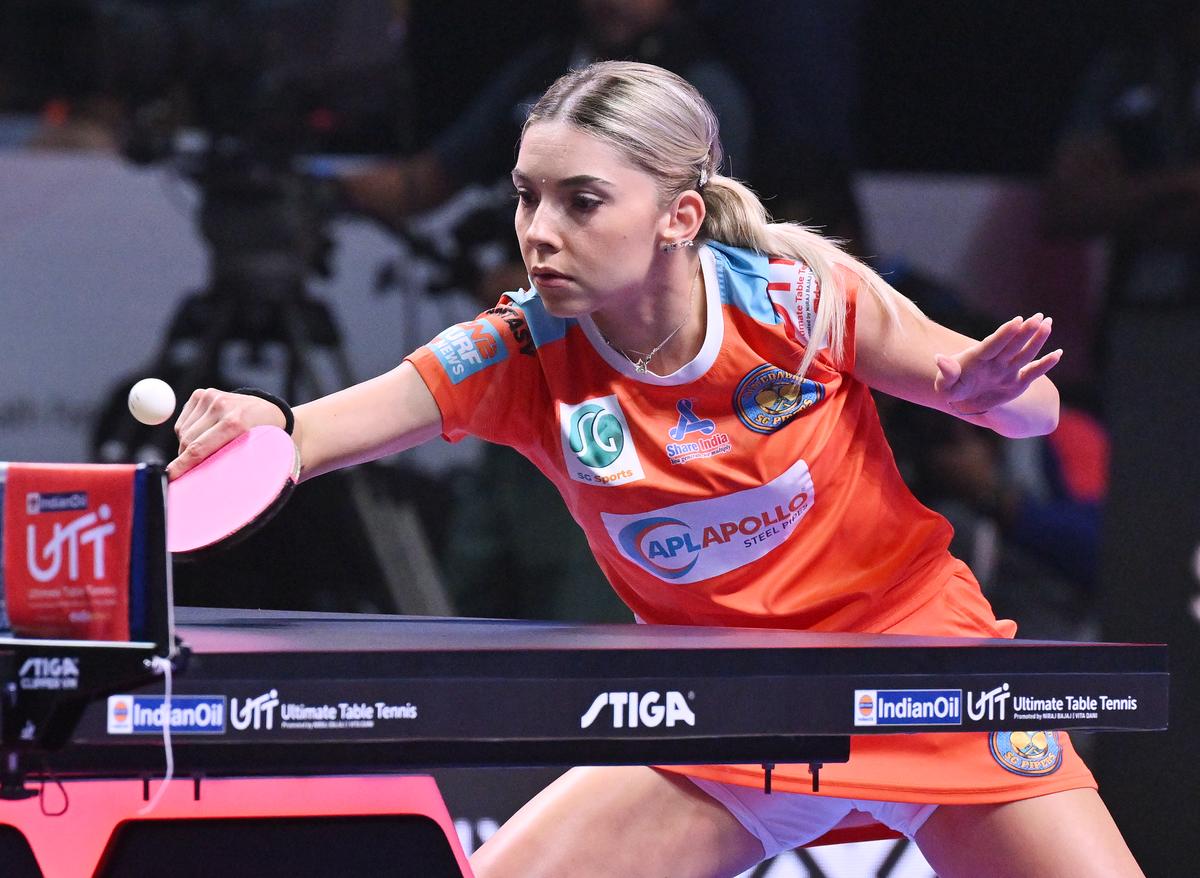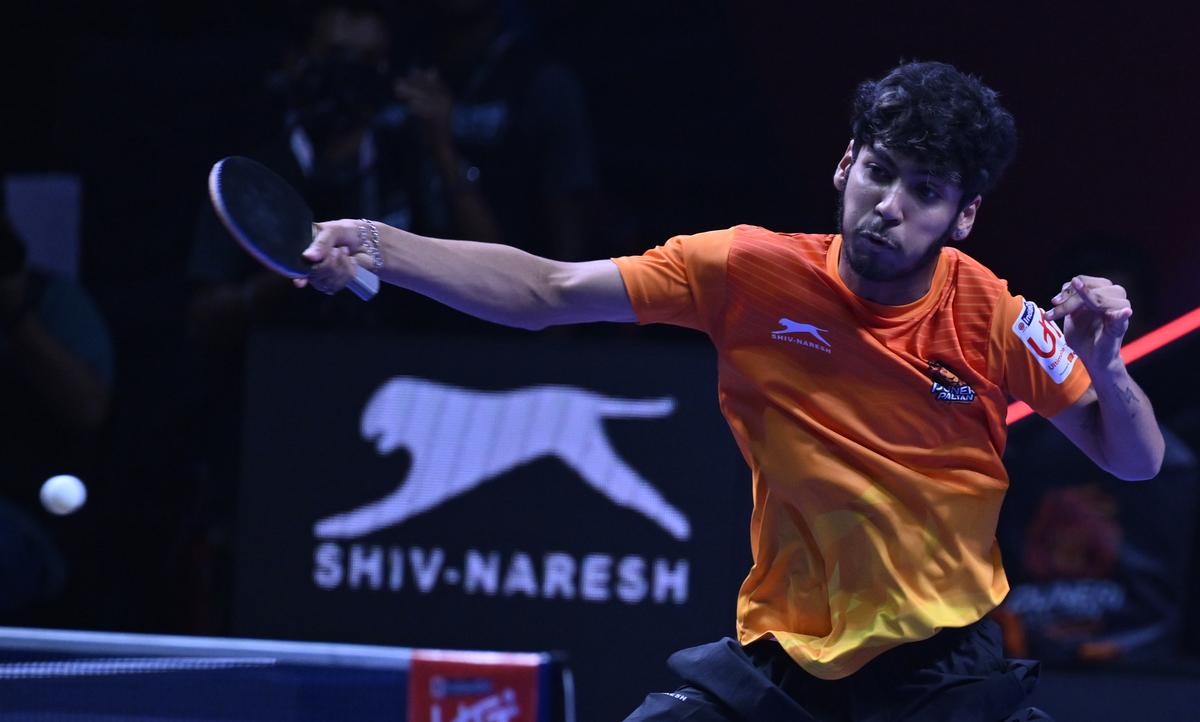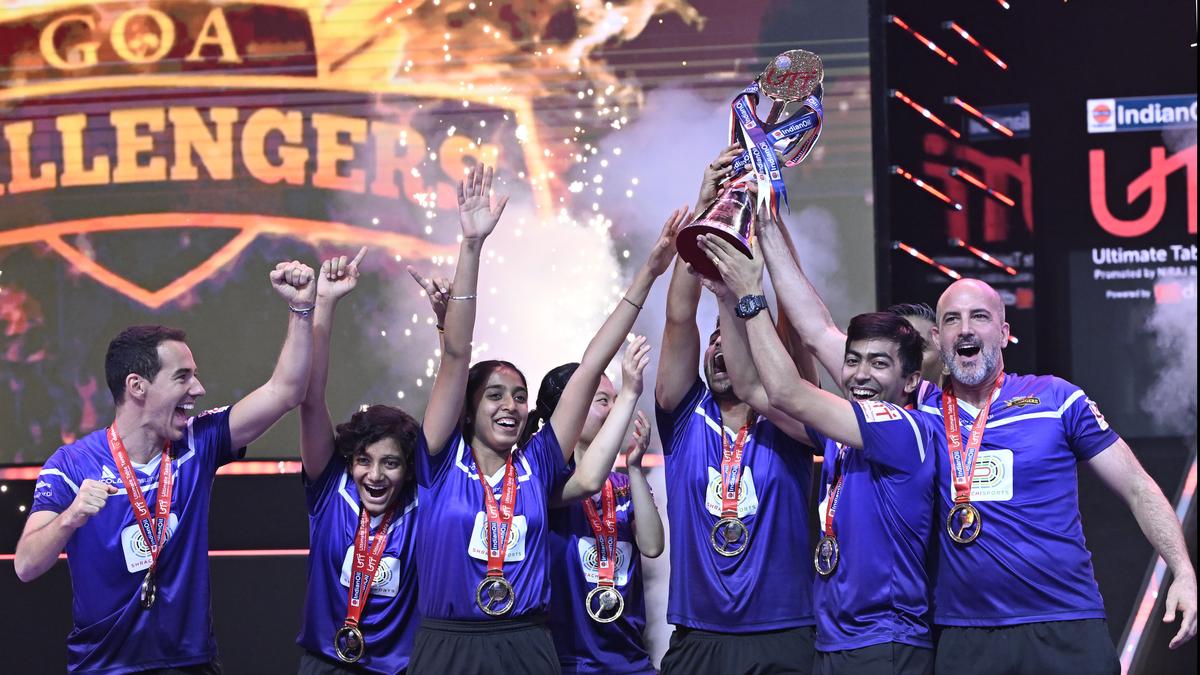UTT 2024 review: The hits, the misses and how it can get better
It has been seven years since the Ultimate Table Tennis (UTT) saw the light of day. Since its inception, the franchise-based league, conducted under the auspices of the Table Tennis Federation of India (TTFI), has gone from strength to strength. With five editions now having rolled by — COVID-19 resulted in a downtime between 2020 and 2022 — it would be fair to give the tournament a once-over and find out to what extent it has lived up to its moniker.
Keeping up the practice from 2019, the UTT, in its entirety, was held at a single venue in 2024. In the first two editions, the UTT caravan had pit stops in three cities, which required players to live out of a suitcase for more than two weeks. Despite noble efforts to popularise table tennis, the sport’s niche audience and player fatigue proved challenging. These hurdles led to a shift in the venue, with the action moving to Chennai this year, following successful seasons in Delhi (2019) and Pune (2023).
Promotion
With two of the biggest Indian stars, Achanta Sharath Kamal and Sathiyan Gnanasekaran, hailing from Chennai, it was safe to presume that the city would welcome some of India’s best paddlers with open arms.
However, empty seats stuck out like sore thumbs on most matchdays, even though only 2,000 of the 8,000 fixed seats in the Jawaharlal Nehru Indoor Stadium (JNIS) were made available for booking. A careful consideration reveals why.
The advertisement campaign left much to be desired. Enveloping state-run buses in bright red UTT vinyl with caricatures of the biggest stars like Manika Batra and Sharath was a marketing genius. Although the move ensured the message got carried around the city on wheels, there were gaps to fill. For starters, the same ad wasn’t propagated in the local language. There was a dearth of banners on the streets, even within a two-mile radius of the stadium hosting the event.
Tickets for the general stand were priced as low as Rs 49 — a masala dosa costs more in the metro city — but the tile to promote the same on the ticket-booking platform didn’t appear on the landing page even with the location set to Chennai.
A total of 500 tickets for the VIP stands were made public, with price tags starting at Rs 1499. These not only provided audiences a side-on view from close quarters but also had lucrative add-ons like a dinner buffet, a chance to interact with stars and win merchandise, and an opportunity to play a few rallies with Adam Bobrow or the ping-pong robot. But none of these added attractions found a mention on the booking application.
Crowds continued to be thin, except when Chennai Lions or Sathiyan’s Dabang Delhi TTC played, with SDAT trainees occasionally filling seats courtesy of complimentary tickets.
“We need to have more publicity. I think people were happy watching the stream. We are a largely improving sport. We should have more people come and experience it first. The ones who watched the grand show wanted to come again. You would have to bring them once, and then they would know the league is organised in the best way possible. I think that would really create a good image. It will get better in the coming seasons,” an optimistic Sathiyan said.
A fault in the stars?
The two previous iterations had seen a better turnout, mostly because of the presence of a vibrant table tennis community in both cities. This year, JNIS saw an average footfall of 600 per match. This can also be attributed to the dwindling number of top foreigners as well. Six of the 12 international stars from the 2023 roster were missing this year.
World No. 13 Romanian Bernadette Szocs, who beat India’s Archana Kamath 11-5, 8-11, 11-7, 11-9 during the women’s team round of 16 match at the Olympics, was the highest-ranked player in the league, followed by Nigeria’s Quadri Aruna (20).
Other prominent international stars included World Team Championships silver medallists Jules Rolland and Lilian Bardet of France, four-time Olympian Joao Monteiro of Portugal, and Spain’s Alvaro Robles, a 2019 Worlds doubles silver medal winner.
Although a top-10 player in the draft always makes for a good show, one has to understand that for a league to accommodate stars of such stature, more cash has to be pumped in. In fact, save the inaugural season in 2017, the league has failed to attract a single top-10 player for the draft. After all, there are no ranking points that a player stands to gain from the UTT. Plus, most players would have opted for a break with the Paris 2024 Summer Games having only concluded recently.

Top star: World No. 13 Romanian Bernadette Szocs was the highest-ranked player in the league followed by Nigeria’s Quadri Aruna (20).
| Photo Credit:
R. Ravindran
Top star: World No. 13 Romanian Bernadette Szocs was the highest-ranked player in the league followed by Nigeria’s Quadri Aruna (20).
| Photo Credit:
R. Ravindran
A sense of identity
The curious case of the missing audience may also be traced back to a majority of fans not identifying themselves with a particular franchise. The reasons are layered.
Having adopted a draft structure to acquire players, the UTT allows the retention of only one player going into the next season. There is no scope for the retention of either the foreign or the Indian coach.
This dynamicity only translates into a major conundrum with every stakeholder — the management, players, fans and journalists alike — struggling to remember the threads a particular player would sport at the beginning of every season. There was even a prominent Indian player who, when asked during the dying stages of the tournament about her most memorable match from the ongoing season, had to be reminded which side Suthasini Sawettabut belonged to!
Developing a core group
The title-winning captain of the Athlead Goa Challengers, Harmeet Desai, concurs that more retentions are the way forward. He said, “We (himself and coach Zoltan Batorfi) were discussing it. I think it will help because sometimes it takes time for the player to understand the coach and vice versa. In the first two matches, it took time (to gel with the others), but if there is a ‘coach retention’ and more players are retained for the next edition, then the bonding would be much better. We have become like family.”
Portuguese coach Francisco Santos, who helped carry the Ahmedabad SG Pipers to the semifinal in its debut season, stares at an uncertain future despite the roaring success. “If I can stay, it will be a pleasure. But I understand the limitations of the format. Even if I end up finding myself in another side, I will continue with the same passion, motivation and goals. I have high hopes of coming back, though,” he said.
Dire need for replacements
Another concern, which gathered steam as the league progressed, was whether the increase in the number of teams this season, up to eight from the earlier six, has diluted the intensity of the event. With a limited pool to pick players from, shoring up the bench to help with substitutions was an area found wanting.
For the lack of viable options, moments ahead of the title-deciding clash, Dabang’s Diya Chitale sustained an ankle injury while limbering up. Despite the provision to have an injury replacement up to 10 minutes prior to the match, Dabang coach Vesna Ojstersek couldn’t field an equally strong athlete.
Dabang’s problems brought to the fore another issue that could be worked on ahead of season six. Diya’s injury could have been the result of a tight calendar that cramped a total of 23 ties over 17 days with no breaks in between.
“It is unfortunate what happened to Diya before the match started. She was playing so well. This tournament is too long. Every day it is the same — practice, match, and practice again. Sometimes matches are back-to-back. It is very difficult for players to stay focused. There should be more space where players shouldn’t feel physically strained. Maybe the matches can be spread across a month,” Vesna opined.
VAR in TT: a possibility?
Additionally, an age-old piece of feedback gained traction again: introducing the option to have a review on close calls when U Mumba’s Aruna felt his ball had landed on Sathiyan’s side of the table. The umpire, though, went ahead and awarded a point to the Indian paddler.
Eyebrows were raised once again when Cho Seungmin of the Jaipur Patriots was wrongly awarded a point against the PBG Bengaluru Smashers.
However, this is something even the International Table Tennis Federation (ITTF) has found difficult to develop in spite of a few dry runs. While the technology for the same can be difficult to devise, baby steps can be taken with appeals getting checked using the slo-mo action replays on the giant screen.
Shining bright like a diamond

Fire in the belly: Ankur Bhattacharjee, 17, showed the UTT what it was missing out on with his wide array of shots.
| Photo Credit:
M VEDHAN
Fire in the belly: Ankur Bhattacharjee, 17, showed the UTT what it was missing out on with his wide array of shots.
| Photo Credit:
M VEDHAN
To look at the positives, the league stayed true to its tagline, “Har Shot Mein Mazaa” (Every shot is exciting). Seventeen days of end-to-end invigorating table tennis action culminated in the Challengers becoming the first team to retain the UTT title.
The tournament also delivered on the promise of giving a solid platform to youngsters, who are going to take up the mantle of making the country proud in the coming years.
There was fire in the eyes of Ankur Bhattacharjee, 17, who showed the UTT what it was missing out on with his blink-and-you-miss forehand topspin, unorthodox yet dangerously effective sidespin, and an impressive wristy backhand. His aggression, which helps the Kolkata lad get into the mind of his opponent, makes him stand out. Although he was sworn in as a Smasher last season, Ankur had to pull out of the tournament to participate in the South Asian Youth Championship.
Then, of course, there was Diya, who sang the redemption song after an insipid debut in 2023. With her pinpoint placements around the half-long region and quick wit, she won 13 of the last 14 games she played. Of these, she sensationally picked three off Manika, thus exacting revenge for the 2-1 defeat last season. This victory ensured Dabang stayed alive in the race to the semifinal.
Diya, however, has been making waves as a paddler for a while now. In the last two years, she has won 12 gold, six silver, and eight bronze medals in various national and international tournaments, a testament to her immense potential. She was also named the most promising junior at the Senior Nationals in 2022, the same year she went on to represent India at the Commonwealth Games and Asian Games.
Jeet Chandra’s giant-slaying tales have now become routine, hence losing the element of surprise. Coming in as a replacement for the Smashers in 2023, Jeet had then slain India No. 1 Harmeet. He was 20 then. The shining prospect lived up to expectations this time around as well, bedazzling one and all while chop-blocking his way to a 3-0 win over Sharath. Jeet’s strong showing caught India coach Massimo Costantini’s attention, securing him a reserve spot on the team for the October Asian Championships in Astana.
Justifying the ‘Ultimate’ in Ultimate Table Tennis isn’t much of an uphill climb. With a few tweaks here and some tinkering there, it could, in the foreseeable future, give global leagues like the Chinese Super League, Bundesliga and French Pro A a run for their money.



